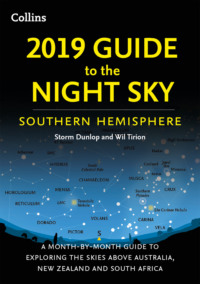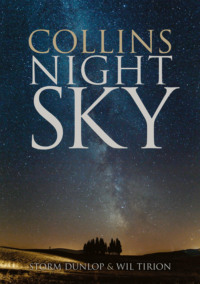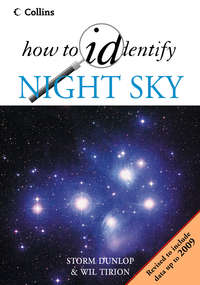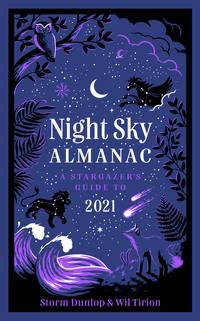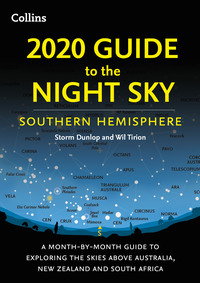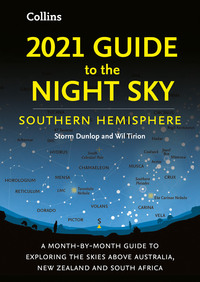
2021 Guide to the Night Sky

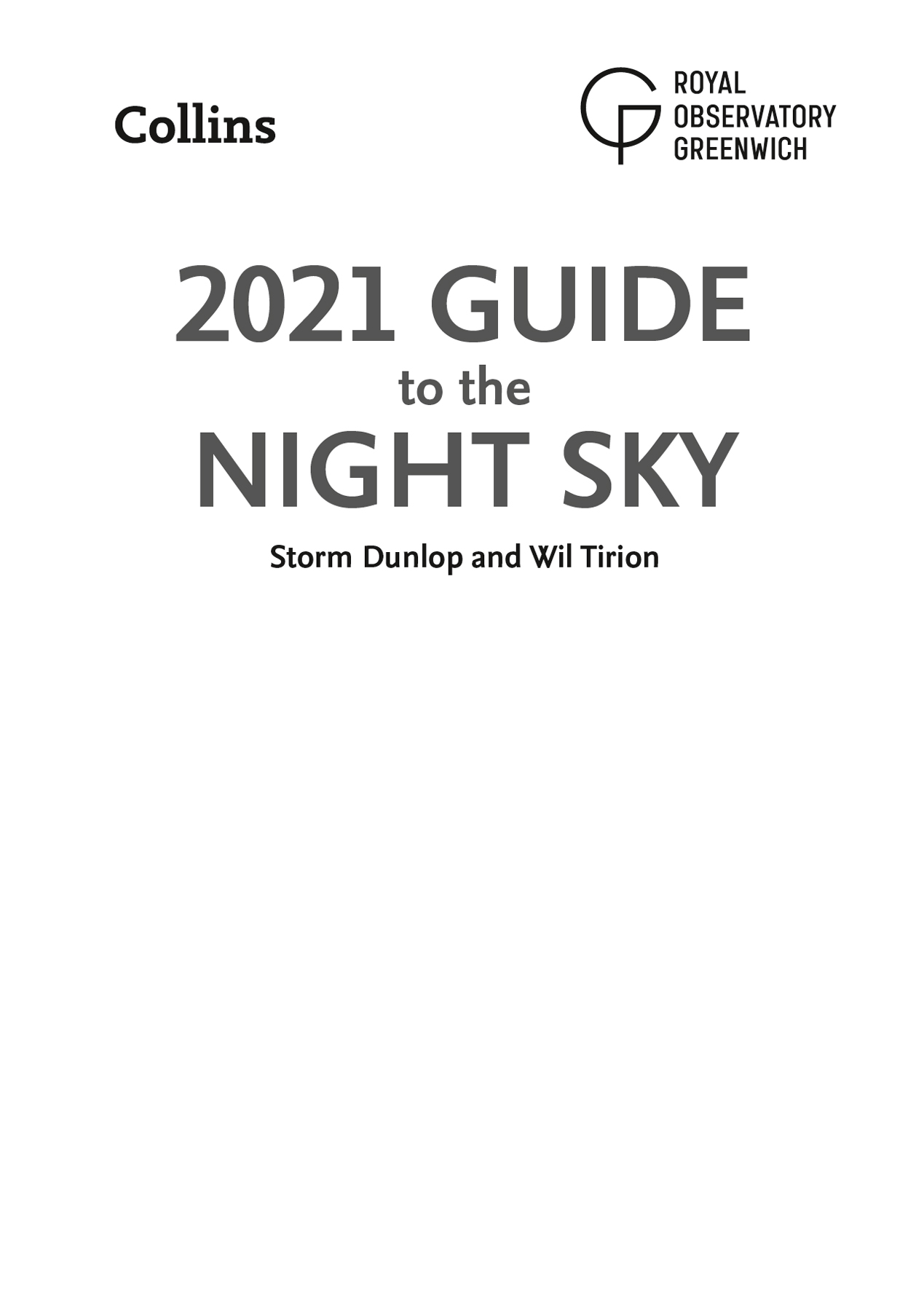
Copyright
Published by Collins
An imprint of HarperCollins Publishers
Westerhill Road
Bishopbriggs
Glasgow G64 2QT
www.harpercollins.co.uk
In association with
Royal Museums Greenwich, the group name for the National Maritime Museum,
Royal Observatory Greenwich, Queen’s House and Cutty Sark
www.rmg.co.uk
© HarperCollins Publishers 2020
Text and illustrations © Storm Dunlop and Wil Tirion
Photographs © see acknowledgements here
Collins ® is a registered trademark of HarperCollins Publishers Ltd
All rights reserved under International and Pan-American Copyright Conventions. By payment of the required fees, you have been granted the non-exclusive, non-transferable right to access and read the text of this e-book on screen. No part of this text may be reproduced, transmitted, downloaded, decompiled, reverse engineered, or stored in or introduced into any information storage and retrieval system, in any form or by any means, whether electronic or mechanical, now known or hereafter invented, without the express written permission of HarperCollins.
The contents of this publication are believed correct at the time of printing. Nevertheless the publisher can accept no responsibility for errors or omissions, changes in the detail given or for any expense or loss thereby caused.
HarperCollins does not warrant that any website mentioned in this title will be provided uninterrupted, that any website will be error free, that defects will be corrected, or that the website or the server that makes it available are free of viruses or bugs. For full terms and conditions please refer to the site terms provided on the website.
A catalogue record for this book is available from the British Library
eBook Edition © September 2020
ISBN 9780008399788
Version: 2020-06-26
Time Zones
The times of events in this book are given in Coordinated Universal Time (UTC), here abbreviated to Universal Time (UT). This time is equivalent to the time on the Greenwich Meridian Greenwich Mean Time (GMT), and is used by astronomers around the world so that observations may be compared easily, without having to convert back from local (zone) times. UT is always given on a 24-hour clock (sometimes known as “military time”). In North America (particularly in the United States) times are generally given as a.m. or p.m., and such times are given on the charts showing the appearance of the sky for each month. Giving the times of individual events as a.m. or p.m. would be complex and confusing, so those times may need to be converted from UT.
North American time zones are shown on this map. To obtain local (zone) time from UT, subtract the hours shown in this table. If the result is less than 12:00, the zone time is a.m.; if greater, subtract a further 12 hours to get the time p.m. Small areas that differ from their nominal time zone are not shown. Many areas (including the whole province of Saskatchewan in Canada) do not use Daylight Saving Time (DST) during the summer. The dates when DST begins and ends are shown on the individual calendars inside the book.
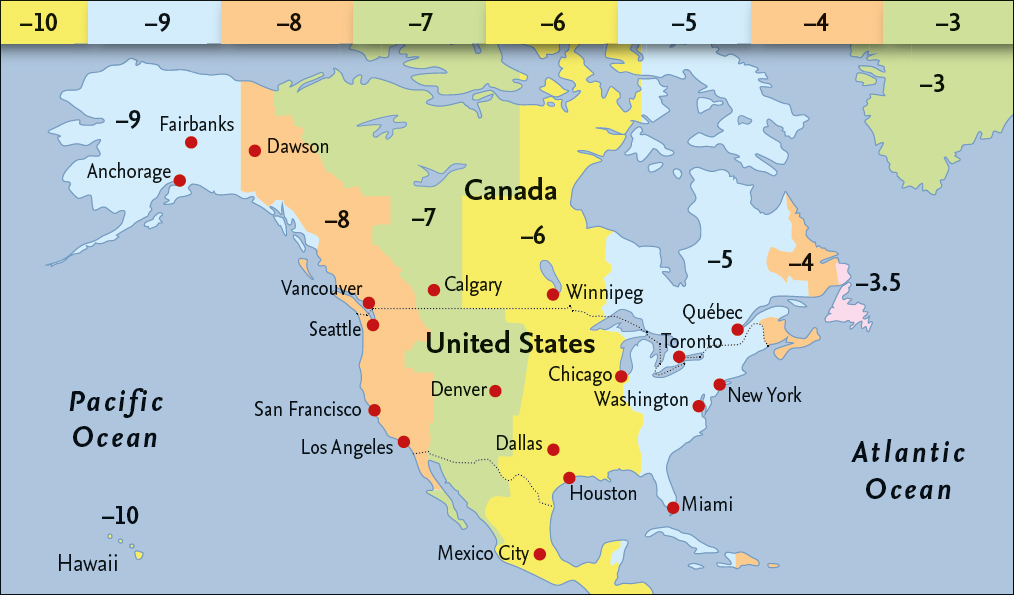
Canada (subtract hours shown from UT) United States (subtract hours shown from UT) Time zone Winter Summer Time zone Winter Summer Newfoundland 03:30 (NST) 02:30 (NDT) Eastern 05:00 (EST) 04:00 (EDT) Atlantic 04:00 (AST) 03:00 (ADT) Central 06:00 (CST) 05:00 (CDT) E. Quebec 04:00 (AST) no DST Mountain 07:00 (MST) 06:00 (MDT) Eastern 05:00 (EST) 04:00 (EDT) Most of Arizona 07:00 (MST) no DST Central 06:00 (CST) 05:00 (CDT) Pacific 08:00 (PST) 07:00 (PDT) Southampton Island 06:00 (CST) no DST Alaska 09:00 (AKST) 08:00 (AKDT) Mountain 07:00 (MST) 06:00 (MDT) Hawaii-Aleutian 10:00 (HAST) no DST Saskatchewan 06:00 (CST) no DST Aleutian Islands 10:00 (HAST) 09:00 (HADT) Pacific 08:00 (PST) 07:00 (PDT) Northwest Territories 08:00 (PST) no DST
Contents
Cover
Title Page
Copyright
Introduction
The Constellations
The Northern Circumpolar Constellations
The Winter Constellations
The Spring Constellations
The Summer Constellations
The Autumn Constellations
The Moon and the Planets
The Moon
Map of the Moon
Eclipses
The Planets
Minor Planets
Comets
Introduction to the Month-by-Month Guide
Month-by-Month Guide
January
February
March
April
May
June
July
August
September
October
November
December
Dark Sky Sites
Glossary and Tables
Further Information
Acknowledgements
About the Publisher
Introduction
The aim of this Guide is to help people find their way around the night sky, by showing how the stars that are visible change from month to month and by including details of various events that occur throughout the year. The objects and events described may be observed with the naked eye, or nothing more complicated than a pair of binoculars.
The conditions for observing naturally vary over the course of the year. During the summer, twilight may persist throughout the night and make it difficult to see the faintest stars. There are three recognized stages of twilight: civil twilight, when the Sun is less than 6° below the horizon; nautical twilight, when the Sun is between 6° and 12° below the horizon; and astronomical twilight, when the Sun is between 12° and 18° below the horizon. Full darkness occurs only when the Sun is more than 18° below the horizon. During nautical twilight, only the very brightest stars are visible. During astronomical twilight, the faintest stars visible to the naked eye may be seen directly overhead, but are lost at lower altitudes. As the diagram shows, during most of June full darkness never occurs at the latitude of Vancouver, BC. Slightly farther south (at Seattle, for example) it is truly dark for about two hours, and for somewhere like Houston, TX, there are at least six hours of darkness.
Another factor that affects the visibility of objects is the amount of moonlight in the sky. At Full Moon, it may be very difficult to see some of the fainter stars and objects, and even when the Moon is at a smaller phase it may seriously interfere with visibility if it is near the stars or planets in which you are interested. A full lunar calendar is given for each month and may be used to see when nights are likely to be darkest and best for observation.
The celestial sphere
All the objects in the sky (including the Sun, Moon and stars) appear to lie at some indeterminate distance on a large sphere, centered on the Earth. This celestial sphere has various reference points and features that are related to those of the Earth. If the Earth’s rotational axis is extended, for example, it points to the North and South Celestial Poles, which are thus in line with the North and South Poles on Earth. Similarly, the celestial equator lies in the same plane as the Earth’s equator, and divides the sky into northern and southern hemispheres. Because this Guide is written for use in North America, the area of the sky that it describes includes the whole of the northern celestial hemisphere and those portions of the southern that become visible at different times of the year. Stars in the far south, however, remain invisible throughout the year, and are not included.
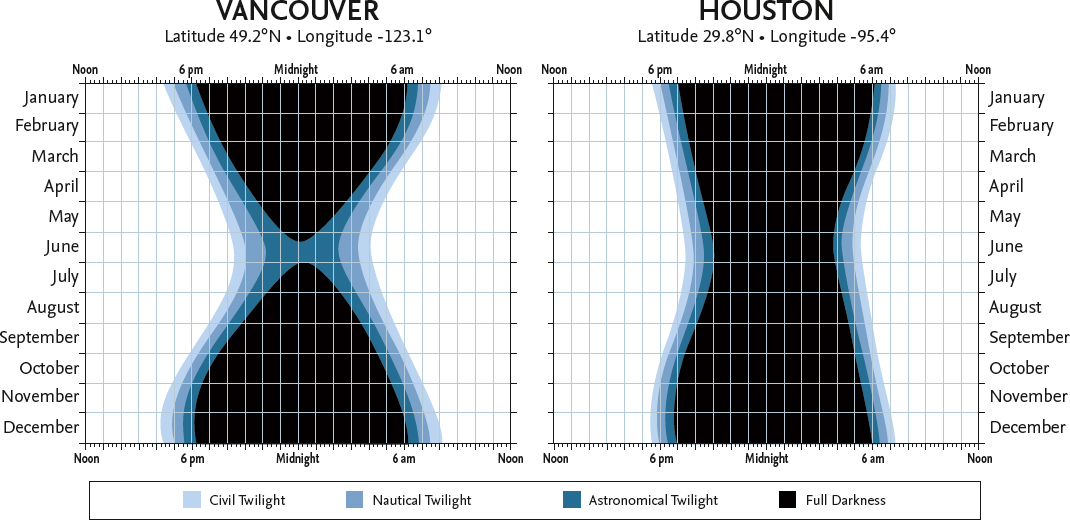
The duration of twilight throughout the year at Vancouver and Houston.
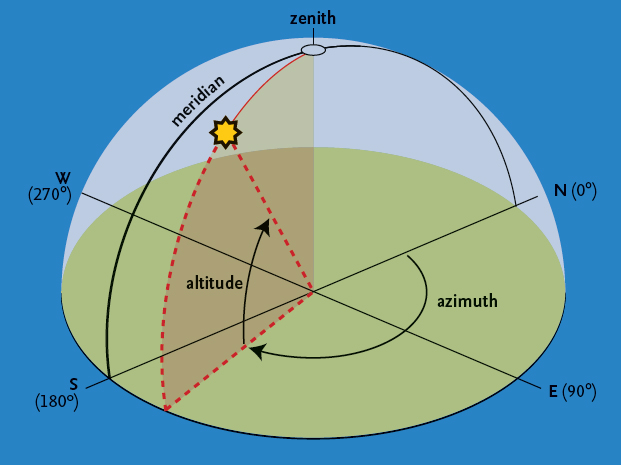
Measuring altitude and azimuth on the celestial sphere.
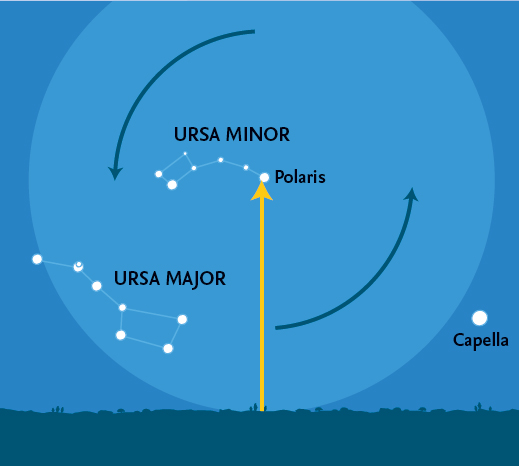
The altitude of the North Celestial Pole equals the observer’s latitude.
It is useful to know some of the special terms for various parts of the sky. As seen by an observer, half of the celestial sphere is invisible, below the horizon. The point directly overhead is known as the zenith, and the (invisible) one below one’s feet as the nadir. The line running from the north point on the horizon, up through the zenith and then down to the south point is the meridian. This is an important invisible line in the sky because objects are highest in the sky, and thus easiest to see, when they cross the meridian in the south. Objects are said to transit when they cross this line in the sky.
In this book, reference is frequently made in the text and in the diagrams to the standard compass points around the horizon. The position of any object in the sky may be described by its altitude (measured in degrees above the horizon), and its azimuth (measured in degrees from north 0°, through east 90°, south 180° and west 270°). Experienced amateurs and professional astronomers also use another system of specifying locations on the celestial sphere, but that need not concern us here, where the simpler method will suffice.
The celestial sphere appears to rotate about an invisible axis, running between the North and South Celestial Poles. The location (i.e., the altitude) of the Celestial Poles depends entirely on the observer’s position on Earth or, more specifically, their latitude. The charts in this book are produced for the latitude of 40°N, so the North Celestial Pole (NCP) is 40° above the northern horizon. The fact that the NCP is fixed relative to the horizon means that all the stars within 40° of the pole are always above the horizon and may, therefore, always be seen at night, regardless of the time of year. This northern circumpolar region is an ideal place to begin learning the sky, and ways to identify the circumpolar stars and constellations will be described shortly.
The ecliptic and the zodiac
Another important line on the celestial sphere is the Sun’s apparent path against the background stars – in reality the result of the Earth’s orbit around the Sun. This is known as the ecliptic. The point where the Sun, apparently moving along the ecliptic, crosses the celestial equator from south to north is known as the vernal (or spring) equinox, which occurs on March 20. At this time (and at the autumnal equinox, on September 22 or 23, when the Sun crosses the celestial equator from north to south) day and night are almost exactly equal in length. (There is a slight difference, but that need not concern us here.) The vernal equinox is currently located in the constellation of Pisces, and is important in astronomy because it defines the zero point for a system of celestial coordinates, which is, however, not used in this Guide.

The Sun crossing the celestial equator in spring.
The Moon and planets are to be found in a band of sky that extends 8° on either side of the ecliptic. This is because the orbits of the Moon and planets are inclined at various angles to the ecliptic (i.e., to the plane of the Earth’s orbit). This band of sky is known as the zodiac and, when originally devised, consisted of 12 constellations, all of which were considered to be exactly 30° wide. When the constellation boundaries were formally established by the International Astronomical Union in 1930, the exact extent of most constellations was altered and, nowadays, the ecliptic passes through 13 constellations. Because of the boundary changes, the Moon and planets may actually pass through several other constellations that are adjacent to the original 12.
The constellations
Since ancient times, the celestial sphere has been divided into various constellations, most dating back to antiquity and usually associated with certain myths or legendary people and animals. Nowadays, the boundaries of the constellations have been fixed by international agreement and their names (in Latin) are largely derived from Greek or Roman originals. Some of the names of the most prominent stars are of Greek or Roman origin, but many are derived from Arabic names. Many bright stars have no individual names and, for many years, stars were identified by terms such as “the star in Hercules’ right foot.” A more sensible scheme was introduced by the German astronomer Johannes Bayer in the early 17th century. Following his scheme – which is still used today – most of the brightest stars are identified by a Greek letter followed by the genitive form of the constellation’s Latin name. An example is the Pole Star, also known as Polaris and α Ursae Minoris (abbreviated α UMi). The Greek alphabet is shown here with a list of all the constellations that may be seen from latitude 40°N, together with abbreviations, their genitive forms and English names here. Other naming schemes exist for fainter stars, but are not used in this book.
Asterisms
Apart from the constellations (88 of which cover the whole sky), certain groups of stars, which may form a part of a larger constellation or cross several constellations, are readily recognizable and have been given individual names. These groups are known as asterisms, and the most famous (and well-known) is the “Big Dipper,” the common name for the seven brightest stars in the constellation of Ursa Major, the Great Bear. The names and details of some asterisms mentioned in this book are given in the list here.
Magnitudes
The brightness of a star, planet or other body is frequently given in magnitudes (mag.). This is a mathematically defined scale where larger numbers indicate a fainter object. The scale extends beyond the zero point to negative numbers for very bright objects. (Sirius, the brightest star in the sky is mag. -1.4.) Most observers are able to see stars to about mag. 6, under very clear skies.
The Moon
Although the daily rotation of the Earth carries the sky from east to west, the Moon gradually moves eastwards by approximately its diameter (about half a degree) in an hour. Normally, in its orbit around the Earth, the Moon passes above or below the direct line between Earth and Sun (at New Moon) or outside the area obscured by the Earth’s shadow (at Full Moon). Occasionally, however, the three bodies are more or less perfectly aligned to give an eclipse: a solar eclipse at New Moon or a lunar eclipse at Full Moon. Depending on the exact circumstances, a solar eclipse may be merely partial (when the Moon does not cover the whole of the Sun’s disk), annular (when the Moon is too far from Earth in its orbit to appear large enough to hide the whole of the Sun), or total. Total and annular eclipses are visible from very restricted areas of the Earth, but partial eclipses are normally visible over a wider area.
Somewhat similarly, at a lunar eclipse, the Moon may pass through the outer zone of the Earth’s shadow, the penumbra (in a penumbral eclipse, which is not generally perceptible to the naked eye), so that just part of the Moon is within the darkest part of the Earth’s shadow, the umbra (in a partial eclipse); or completely within the umbra (in a total eclipse). Unlike solar eclipses, lunar eclipses are visible from large areas of the Earth.
Occasionally, as it moves across the sky, the Moon passes between the Earth and individual planets or distant stars, giving rise to an occultation. As with solar eclipses, such occultations are visible from restricted areas of the world.
The planets
Because the planets are always moving against the background stars, they are treated in some detail in the monthly pages and information is given when they are close to other planets, the Moon or any of five bright stars that lie near the ecliptic. Such events are known as appulses or, more frequently, as conjunctions. (There are technical differences in the way these terms are defined and should be used in astronomy, but these need not concern us here.) The positions of the planets are shown for every month on a special chart of the ecliptic.
The term conjunction is also used when a planet is either directly behind or in front of the Sun, as seen from Earth. (Under normal circumstances it will then be invisible.) The conditions of most favorable visibility depend on whether the planet is one of the two known as inferior planets (Mercury and Venus) or one of the three superior planets (Mars, Jupiter and Saturn) that are covered in detail. (Some details of the fainter superior planets, Uranus and Neptune, are included in this Guide, and special charts for both are given here.)
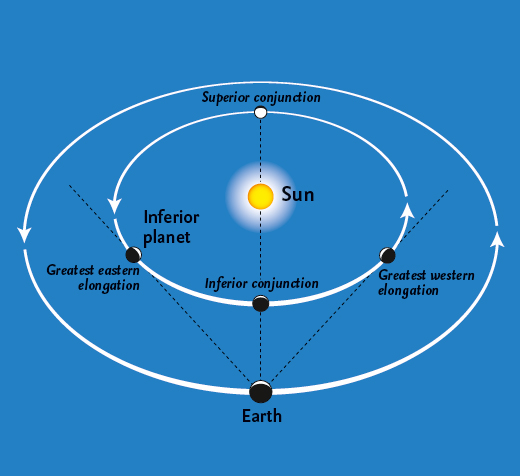
Inferior planet.
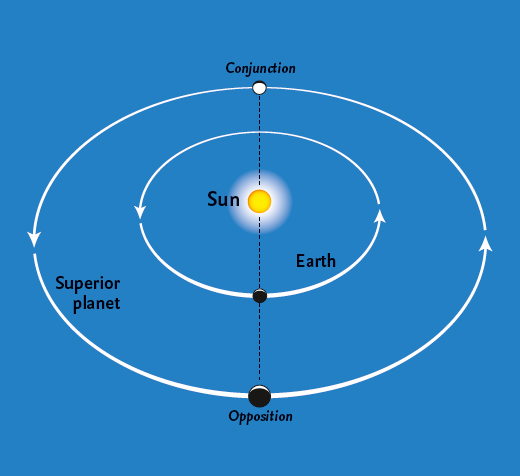
Superior planet.
The inferior planets are most readily seen at eastern or western elongation, when their angular distance from the Sun is greatest. For superior planets, they are best seen at opposition, when they are directly opposite the Sun in the sky, and cross the meridian at local midnight.
It is often useful to be able to estimate angles on the sky, and approximate values may be obtained by holding one hand at arm’s length. The various angles are shown in the diagram, together with the separations of the various stars in the Big Dipper.
Meteors
At some time or other, nearly everyone has seen a meteor – a “shooting star” – as it flashed across the sky. The particles that cause meteors – known technically as “meteoroids” – range in size from that of a grain of sand (or even smaller) to the size of a pea. On any night of the year there are occasional meteors, known as sporadics, that may travel in any direction. These occur at a rate that is normally between three and eight in an hour. Far more important, however, are meteor showers, which occur at fixed periods of the year, when the Earth encounters a trail of particles left behind by a comet or, very occasionally, by a minor planet (asteroid). Meteors always appear to diverge from a single point on the sky, known as the radiant, and the radiants of major showers are shown on the charts. Meteors that come from a circular area 8° in diameter around the radiant are classed as belonging to the particular shower. All others that do not come from that area are sporadics (or, occasionally from another shower that is active at the same time). A list of the major meteor showers is given here.
Although the positions of the various shower radiants are shown on the charts, looking directly at the radiant is not the most effective way of seeing meteors. They are most likely to be noticed if one is looking about 40°–45° away from the radiant position. (This is approximately two hand-spans as shown in the diagram for measuring angles.)
Other objects
Certain other objects may be seen with the naked eye under good conditions. Some were given names in antiquity – Praesepe is one example – but many are known by what are called “Messier numbers,” the numbers in a catalogue of nebulous objects compiled by Charles Messier in the late 18th century. Some, such as the Andromeda Galaxy, M31, and the Orion Nebula, M42, may be seen by the naked eye, but all those given in the list will benefit from the use of binoculars. Apart from galaxies, such as M31, which contain thousands of millions of stars, there are also two types of cluster: open clusters, such as M45, the Pleiades, which may consist of a few dozen to some hundreds of stars; and globular clusters, such as M13 in Hercules, which are spherical concentrations of many thousands of stars. One or two gaseous nebulae, consisting of gas illuminated by stars within them, are also visible. The Orion Nebula, M42, is one, and is illuminated by the group of four stars, known as the Trapezium, which may be seen within it by using a good pair of binoculars.
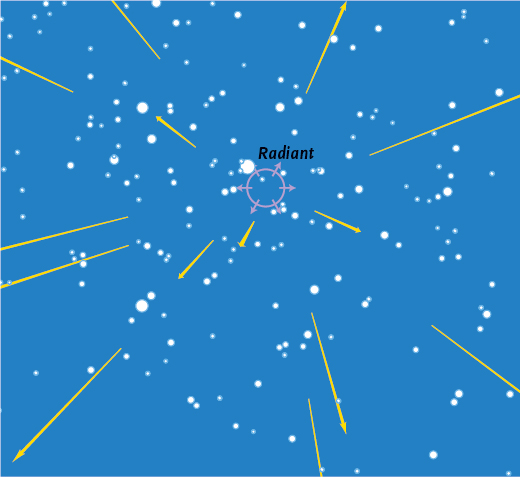
Meteor shower (showing the April Lyrid radiant).


